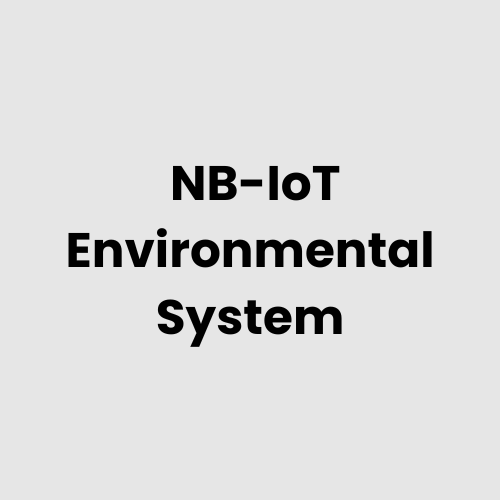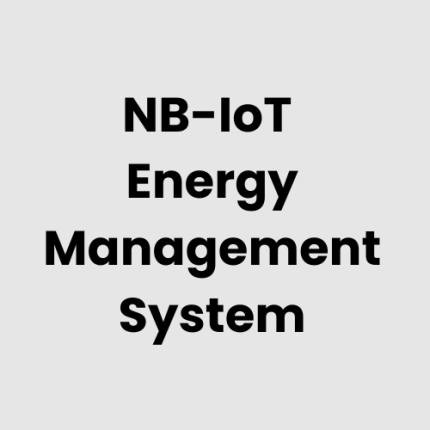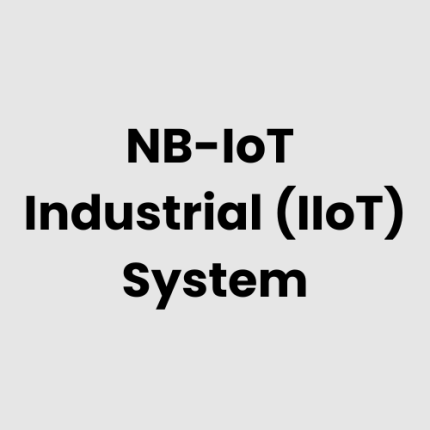Description
Technical Architecture
The NB-IoT Enabled Environmental Monitoring System offers a robust and scalable solution to monitor and manage environmental conditions in real-time. The architecture of the system is divided into three key layers:
- Sensor Layer: This layer includes a wide variety of sensors that collect data on environmental parameters such as air quality (PM2.5, CO2), temperature, humidity, noise levels, light intensity, and soil moisture. These sensors are connected to the system via NB-IoT modules, ensuring low-power and long-range connectivity, making it ideal for monitoring remote or expansive areas.
- Connectivity Layer: The NB-IoT network provides connectivity for data transmission from the sensors to central processing units. This layer ensures reliable communication across both urban and rural environments, even in areas where traditional Wi-Fi or cellular connectivity may be unavailable.
- Data Processing and Management Layer: The collected sensor data is transmitted to a centralized data management platform, either hosted locally or in the cloud. This layer processes the raw data and transforms it into actionable insights, offering real-time monitoring and analytics for environmental conditions, and enabling proactive decision-making.
This architecture is designed to support a variety of use cases, including smart city projects, agricultural monitoring, industrial facilities, and environmental compliance systems.
Hardware of the NB-IoT Enabled Environmental Monitoring System
The NB-IoT Enabled Environmental Monitoring System consists of the following key hardware components:
- Environmental Sensors: Devices that measure a range of environmental parameters such as air quality, temperature, humidity, and noise levels. These sensors are designed for high accuracy and long-term reliability in various environmental conditions.
- NB-IoT Communication Modules: These modules are embedded into the sensors and other devices, allowing seamless, low-power, and secure communication with the NB-IoT .
- Gateways: For areas with limited NB-IoTcoverage, gateways serve as intermediaries, collecting data from multiple sensors and relaying it to the central system.
- Edge Devices: These devices enable local processing and can filter or pre-process data before transmission to reduce bandwidth requirements.
- Cloud or On-Premise Servers: Servers process, store, and analyze data collected from environmental sensors, providing a platform for real-time reporting, alerts, and visualizations.
- Power Solutions: Solar-powered options or backup batteries are available to ensure continuous operation of sensors and devices in remote locations or areas without easy access to power.
Physical Placement Considerations
The placement of the hardware in the NB-IoT Enabled Environmental Monitoring System is critical to achieving accurate and reliable data collection:
- Sensors: Environmental sensors should be strategically placed in areas where key parameters need to be monitored, such as near air vents, water bodies, factories, or agricultural fields. Sensors should be positioned in open areas with minimal obstruction to ensure optimal readings.
- Gateways: Gateways should be installed in areas with strong NB-IoTsignal coverage and a clear line of sight to the sensors. Gateways should be placed high enough to cover a wide range of devices and to mitigate interference from buildings or obstructions.
- Edge Devices: These devices should be located close to sensor clusters to perform local data processing and ensure efficient data transmission to the central servers.
- Power Sources: Sensors and edge devices often rely on battery or solar power, so placement must consider access to sunlight or proximity to power outlets. Solar-powered systems should be oriented to maximize sunlight exposure.
Hardware Architecture
The hardware architecture of the NB-IoT Enabled Environmental Monitoring System is designed for flexibility and scalability:
- Environmental Sensors: These are the primary data collection points in the system. They monitor various environmental conditions like air quality, temperature, humidity, and noise. Each sensor is equipped with NB-IoT connectivity for secure and low-power communication.
- Communication Infrastructure: NB-IoT modulesembedded in sensors and edge devices communicate with NB-IoT gateways. These gateways ensure that data from remote sensors is transmitted reliably to central servers.
- Edge Devices: These are used for local data processing and aggregation. Edge devices minimize the amount of raw data sent to the central system by filtering or pre-processing the data.
- Centralized Data Platform: The data platform, whether cloud-based or on-premise, serves as the hub for data storage, analysis, and reporting. It processes incoming data streams and provides insights into environmental conditions.
- Power Solutions: The system’s power solutions are integral to ensuring reliable operation in remote or off-grid locations. Solar panels and backup battery systems provide continuous power, even in the absence of conventional electricity sources.
Deployment Considerations
Deploying the NB-IoT Enabled Environmental Monitoring System requires attention to several factors:
- Network Availability: Ensure that NB-IoT coverage is available in the deployment area, especially in remote locations. If network coverage is insufficient, gateways may be used to bridge communication gaps.
- Scalability: The system is designed to be scalable, supporting a wide range of sensor types and large numbers of devices across diverse locations. New sensors can easily be added to the network as monitoring needs grow.
- Environmental Conditions: The system must be deployed with consideration of environmental conditions. Sensors should be protected from extreme weather and environmental hazards to ensure durability and accurate readings.
- Security: Strong security measures, including encrypted data transmission and secure access controls, should be implemented to safeguard sensitive environmental data.
- Power Management: For remote or off-grid deployments, consider energy-efficient sensors and edge devices, and ensure adequate power supply systems such as solar panels and backup batteries.
List of Relevant Industry Standards and Regulations
- ISO 14001 – Environmental management systems
- ISO 9001:2015 – Quality management systems
- IEEE 802.15.4 – Low-rate wireless personal area networks
- ITU-R M.1457 – Technical specifications for NB-IoT
- GDPR (General Data Protection Regulation) – Data protection and privacy in the EU
- NIST SP 800-53 – Security controls for federal information systems
- CE Marking – Conformance to European safety standards
- WMO (World Meteorological Organization) guidelines – Environmental monitoring standards
Local Server Version
For deployments where data privacy and control are paramount, the NB-IoT Enabled Environmental Monitoring System can operate with a local server setup. This offers the following advantages:
- On-Premise Control: All data is stored and processed on-site, providing greater control over sensitive environmental data.
- Reduced Latency: By processing data locally, the system can deliver faster response times for real-time monitoring and decision-making.
- Enhanced Security: Local servers reduce reliance on external cloud providers, offering more stringent security measures for environmental data.
- Cost Efficiency: Local servers eliminate ongoing cloud service costs, which can be a cost-effective solution for large-scale or long-term deployments.
Cloud Integration and Data Management
For customers seeking a more centralized and scalable solution, the NB-IoT Enabled Environmental Monitoring System offers cloud integration:
- Scalable Storage and Processing: Cloud platforms offer virtually unlimited storage and computing power, allowing for large volumes of environmental data to be processed and stored.
- Real-Time Monitoring and Alerts: The cloud-based platform provides real-time monitoring and instant alerts for environmental conditions, helping to address issues as they arise.
- Advanced Analytics: Cloud services enable advanced data analytics, offering insights into trends, anomalies, and performance benchmarks, which can inform future strategies.
- Remote Access: Authorized personnel can access data and reports remotely from anywhere, facilitating management and decision-making across dispersed locations.
- Security and Compliance: Cloud providers ensure compliance with environmental regulations and data security standards, safeguarding sensitive environmental data.
At GAO Tek Inc., we understand the importance of environmental monitoring for compliance and sustainability efforts. Our NB-IoT Enabled Environmental Monitoring System is designed to provide accurate, real-time data with flexible deployment options. Whether you’re looking for a local server solution or a cloud-based system, we are here to support your environmental monitoring needs. Contact us to learn how our solution can benefit your operations.
GAO Case Studies of NB-IoT Enabled Environmental Monitoring System
USA Case Studies
- San Francisco, California
In this coastal city, NB-IoT sensors were deployed to monitor air quality levels, providing critical data on pollutants. These insights assist urban planners in aligning with EPA guidelines on air quality. - Denver, Colorado
A project in Denver utilized NB-IoT to measure snowmelt rates in the Rocky Mountains, aiding in water resource management and flood prevention efforts. - Miami, Florida
NB-IoT technology enabled real-time monitoring of rising sea levels in Miami, supporting the National Oceanic and Atmospheric Administration’s resilience programs. - Seattle, Washington
Seattle leveraged NB-IoT systems for monitoring urban tree health, providing data to enhance green spaces as part of the U.S. Forest Service’s urban forestry initiatives. - Chicago, Illinois
Deployed along the Chicago River, NB-IoT devices tracked water quality metrics such as pH and turbidity. This project aligns with Chicago’s waterway improvement programs. - Phoenix, Arizona
In Phoenix, NB-IoT sensors monitored groundwater levels, supporting sustainable practices outlined by the S. Bureau of Reclamation. - New York City, New York
NB-IoT devices monitored urban air pollution in real time, contributing to the NYC Clean Air initiative to improve public health in densely populated areas. - Austin, Texas
Austin implemented NB-IoT to track soil moisture levels, aiding water conservation efforts. The project supports Texas Water Development Board initiatives. - Boston, Massachusetts
In Boston, NB-IoT technology facilitated monitoring of harbor water conditions, ensuring compliance with environmental standards set by Massachusetts Department of Environmental Protection. - Portland, Oregon
Portland’s NB-IoT project monitored wildfire risks through vegetation health tracking, aligning with Oregon’s wildfire prevention strategies. - Los Angeles, California
NB-IoT sensors in Los Angeles monitored particulate matter and smog levels, helping the city comply with California Air Resources Board regulations. - Salt Lake City, Utah
Salt Lake City utilized NB-IoT systems to track Great Salt Lake water levels, contributing to sustainability projects under the Utah Division of Water Resources. - Minneapolis, Minnesota
NB-IoT technology in Minneapolis monitored urban runoff effects on local lakes, supporting conservation initiatives by the Minnesota Department of Natural Resources. - Houston, Texas
Houston implemented NB-IoT systems to measure air quality during industrial operations, ensuring adherence to EPA air quality standards. - Philadelphia, Pennsylvania
NB-IoT sensors in Philadelphia monitored stormwater drainage systems, reducing urban flooding risks and aligning with the city’s Water Department initiatives.
Canada Case Studies
- Toronto, Ontario
Toronto employed NB-IoT technology to monitor urban heat islands, gathering data to inform city climate strategies. - Vancouver, British Columbia
In Vancouver, NB-IoT sensors tracked coastal erosion rates, aiding in sustainable development aligned with British Columbia’s coastal management programs.
Navigation Menu for NB-IoT
Navigation Menu for IoT
- LORAWAN
- Wi-Fi HaLow
- Z-WAVE
- BLE & RFID
- NB-IOT
- CELLULAR IOT
- GPS IOT
- IOT SENSORS
- EDGE COMPUTING
- IOT SYSTEMS
Our products are in stock and can be shipped anywhere in the continental U.S. or Canada from our local warehouse. For any further information, please fill out this form or email us.
We are actively looking for partners who are like us located in the U.S. and Canada. For more information on partnering with GAO, please visit Partner with GAO Tek Inc. It lists various ways to partner with GAO, such as OEM Partnerships, Technology Integration, Distribution and Reselling Opportunities, Presenting at the Leading Event Tek Summit, Joint R&D Projects, Training and Consulting Services, Industry-Specific Collaborations, Research and Academic Partnerships.



